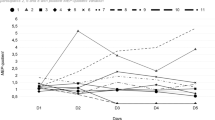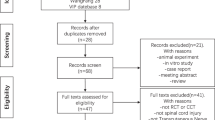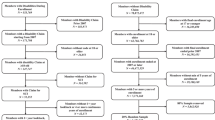Abstract
Objectives:
To conduct a systematic review and meta-analysis to examine the effect of transcranial direct current stimulation (tDCS) on reducing neuropathic pain intensity in individuals with spinal cord injury (SCI).
Methods:
Medline, CINAHL, EMBASE and PsycINFO databases were searched for all relevant articles published from 1980 to November 2014. Trials were included if (i) tDCS intervention group and a placebo control group were present; (ii) at least 50% of participants in the study had an SCI and there were at least three participants; (iii) participants were aged 18 years or older; and (iv) persistent pain for at least 3 months. Studies were excluded if: (i) the tDCS intervention group was compared with an active treatment group; (ii) there was insufficient reporting detail to enable pooling of data; and (iii) it was a nonclinical trial (that is, reviews, epidemiology, basic sciences). A standardized mean difference (SMD)±s.e. and 95% confidence interval (CI) was calculated for each outcome of interest and the results were pooled using a fixed or random effects model, as appropriate. Effect sizes were interpreted as: small >0.2, moderate >0.5, large >0.8.
Results:
Five studies met inclusion criteria of which four were randomized controlled trials and one was a prospective controlled trial. The pooled analysis found a significant effect of tDCS on reducing neuropathic pain after SCI post treatment (SMD=0.510±0.202; 95% CI, 0.114–0.906; P<0.012); however, this effect was not maintained at follow-up (SMD=0.353±0.272; 95% CI, −0.179 to 0.886; P<0.194). A reduction of 1.33 units on a 10-item scale was observed post treatment. No significant adverse events were reported.
Conclusion:
Meta-analytic results indicate a moderate effect of tDCS in reducing neuropathic pain among individuals with SCI; however, the effect was not maintained at follow-up. A mean pooled decrease of 1.33 units on a 10-item scale was found post treatment. Several factors were implicated in the effectiveness of tDCS in reducing pain. Due to the limited number of studies and lack of follow-up, more evidence is required before treatment recommendations can be made.
Similar content being viewed by others
Log in or create a free account to read this content
Gain free access to this article, as well as selected content from this journal and more on nature.com
or
References
Treede RD, Jensen TS, Campbell JN, Cruccu G, Dostrovsky JO, Griffin JW et al. Neuropathic pain: redefinition and a grading system for clinical and research purposes. Neurology 2008; 70: 1630–1635.
Finnerup NB . Pain in patients with spinal cord injury. Pain 2013; 154: S71–S76.
Siddall PJ, McClelland JM, Rutkowski SB, Cousins MJ . A longitudinal study of the prevalence and characteristics of pain in the first 5 years following spinal cord injury. Pain 2003; 103: 249–257.
Bonica JJ . Introduction: semantic, epidemiologic, and educational issuers. In: Casey KL (ed.). Pain and Central Nervous System Disease: The Central Pain Syndromes. Raven Press:: NY, USA. 1991.
Margot-Duclot A, Tournebise H, Ventura M, Fattal C . What are the risk factors of occurence and chronicity of neuropathic pain in spinal cord injury patients? Ann Phys Rehabil Med 2009; 52: 111–123.
Dworkin RH, O’Connor AB, Backonja M, Farrar JT, Finnerup NB, Jensen TS et al. Pharmacologic management of neuropathic pain: evidence-based recommendations. Pain 2007; 132: 237–251.
Gordon DB, Love G . Pharmacologic management of neuropathic pain. Pain Manag Nurs 2004; 5: 19–33.
Nicholson BD . Evaluation and treatment of central pain syndromes. Neurology 2004; 62: S30–S36.
Siddall PJ, Loeser JD . Pain following spinal cord injury. Spinal Cord 2001; 39: 63–73.
Wallace BA, Ashkan K, Benabid AL . Deep brain stimulation for the treatment of chronic, intractable pain. Neurosurg Clin N Am 2004; 15: 343–357.
Knechtel L, Thienel R, Schall U . Transcranial direct current stimulation: Neurophysiology and clinical applications. Neuropsychiatry 2013; 3: 89–96.
Fregni F, Boggio PS, Lima MC, Ferreira MJ, Wagner T, Rigonatti SP et al. A sham-controlled, phase II trial of transcranial direct current stimulation for the treatment of central pain in traumatic spinal cord injury. Pain 2006; 122: 197–209.
García-Larrea L, Peyron R, Mertens P, Lavenne F, Le Bars D, Convers P et al. Electrical stimulation of motor cortex for pain control: a combined PET-scan and electrophysiological study. Pain 1999; 83: 259–273.
Reidler JS, Mendonca ME, Santana MB, Wang X, Lenkinski R, Motta AF et al. Effects of motor cortex modulation and descending inhibitory systems on pain thresholds in healthy subjects. J Pain 2012; 13: 450–458.
Moseley AM, Herbert RD, Sherrington C, Maher CG . Evidence for physiotherapy practice: a survey of the Physiotherapy Evidence Database (PEDro). Aust J Physiother 2002; 48: 43–49.
Foley NC, Bhogal SK, Teasell RW, Bureau Y, Speechley MR . Estimates of quality and reliability with the physiotherapy evidence-based database scale to assess the methodology of randomized controlled trials of pharmacological and nonpharmacological interventions. Physical Therapy 2006; 86: 817–824.
Cohen J . Statistical Power And Analysis for Behavioral Sciences. Academic Press: New York. 1988.
Lipsey M, Wilson D . Practical Meta-Analysis. SAGE Publications Inc.: Thousand Oaks, CA, USA. 2001.
Soler MD, Kumru H, Pelayo R, Vidal J, Tormos J, Fregni F et al. Effectiveness of transcranial direct current stimulation and visual illusion on neuropathic pain in spinal cord injury. Brain 2010; 133: 2565–2577.
Ngernyam N, Jensen MP, Arayawichanon P, Auvichayapat N, Tiamkao S, Janjarasjitt S et al. The effects of transcranial direct current stimulation in patients with neuropathic pain from spinal cord injury. Clin Neurophysiol 2014; 126: 382–390.
Wrigley PJ, Gustin SM, McIndoe LN, Chakiath RJ, Henderson LA, Siddall PJ . Longstanding neuropathic pain after spinal cord injury is refractory to transcranial direct current stimulation: A randomized controlled trial. Pain 2013; 154: 2178–2184.
Yoon EJ, Kim YK, Kim HR, Kim SE, Lee Y, Shin HI . Transcranial direct current stimulation to lessen neuropathic pain after spinal cord injury: a mechanistic PET study. Neurorehabil Neural Repair 2014; 28: 250–259.
Ostelo RW, Deyo RA, Stratford P, Waddell G, Croft P, Von Korff M et al. Interpreting change scores for pain and functional status in low back pain: towards international consensus regarding minimal important change. Spine 2008; 33: 90–94.
Hanley M, Jensen M, Ehde D, Robinson L, Cardenas D, Turner J et al. Clinically significant change in pain intensity ratings in persons with spinal cord injury or amputation. Clin J Pain 2006; 22: 25–31.
Luedtke K, Rushton A, Wright C, Geiss B, Juergens TP, May A . Transcranial direct current stimulation for the reduction of clinical and experimentally induced pain: A systematic review and meta-analysis. Clin J Pain 2012; 28: 452–461.
Mori F, Codecà C, Kusayanagi H, Monteleone F, Buttari F, Fiore S et al. Effects of anodal transcranial direct current stimulation on chronic neuropathic pain in patients with multiple sclerosis. J Pain 2010; 11: 436–442.
Boggio PS, Nunes A, Rigonatti SP, Nitsche MA, Pascual-Leone A, Fregni F . Repeated sessions of noninvasive brain DC stimulation is associated with motor function improvement in stroke patients. Restor Neurol Neurosci 2007; 25: 123–129.
Lynch ME, Campbell FA, Clark AJ, Dunbar MJ, Goldstein D, Peng P et al. Waiting for treatment for chronic pain–a survey of existing benchmarks: Toward establishing evidence-based benchmarks for medically acceptable waiting times. Pain Res Manag 2007; 12: 245.
Liebetanz D, Nitsche MA, Tergau F, Paulus W . Pharmacological approach to the mechanisms of transcranial DC‐stimulation‐induced after‐effects of human motor cortex excitability. Brain 2002; 125: 2238–2247.
Turk DC, Dworkin RH, Allen RR, Bellamy N, Brandenburg N, Carr DB et al. Core outcome domains for chronic pain clinical trials: IMMPACT recommendations. Pain 2003; 106: 337–345.
Acknowledgements
We acknowledge Ontario Neurotrauma Foundation and Rick Hansen Institute for their continued support.
Author information
Authors and Affiliations
Corresponding author
Ethics declarations
Competing interests
The authors declare no conflict of interest.
Rights and permissions
About this article
Cite this article
Mehta, S., McIntyre, A., Guy, S. et al. Effectiveness of transcranial direct current stimulation for the management of neuropathic pain after spinal cord injury: a meta-analysis. Spinal Cord 53, 780–785 (2015). https://doi.org/10.1038/sc.2015.118
Received:
Revised:
Accepted:
Published:
Issue date:
DOI: https://doi.org/10.1038/sc.2015.118
This article is cited by
-
Neuropathic Pain and Spinal Cord Injury: Management, Phenotypes, and Biomarkers
Drugs (2023)
-
The CanPain SCI clinical practice guidelines for rehabilitation management of neuropathic pain after spinal cord injury: 2021 update
Spinal Cord (2022)
-
Effects of transcranial direct current stimulation followed by exercise on neuropathic pain in chronic spinal cord injury: a double-blinded randomized controlled pilot trial
Spinal Cord (2021)
-
Motor cortical excitability behavior in chronic spinal cord injury neuropathic pain individuals submitted to transcranial direct current stimulation—case reports
Spinal Cord Series and Cases (2020)
-
Transcranial direct current stimulation as a motor neurorehabilitation tool: an empirical review
BioMedical Engineering OnLine (2017)



